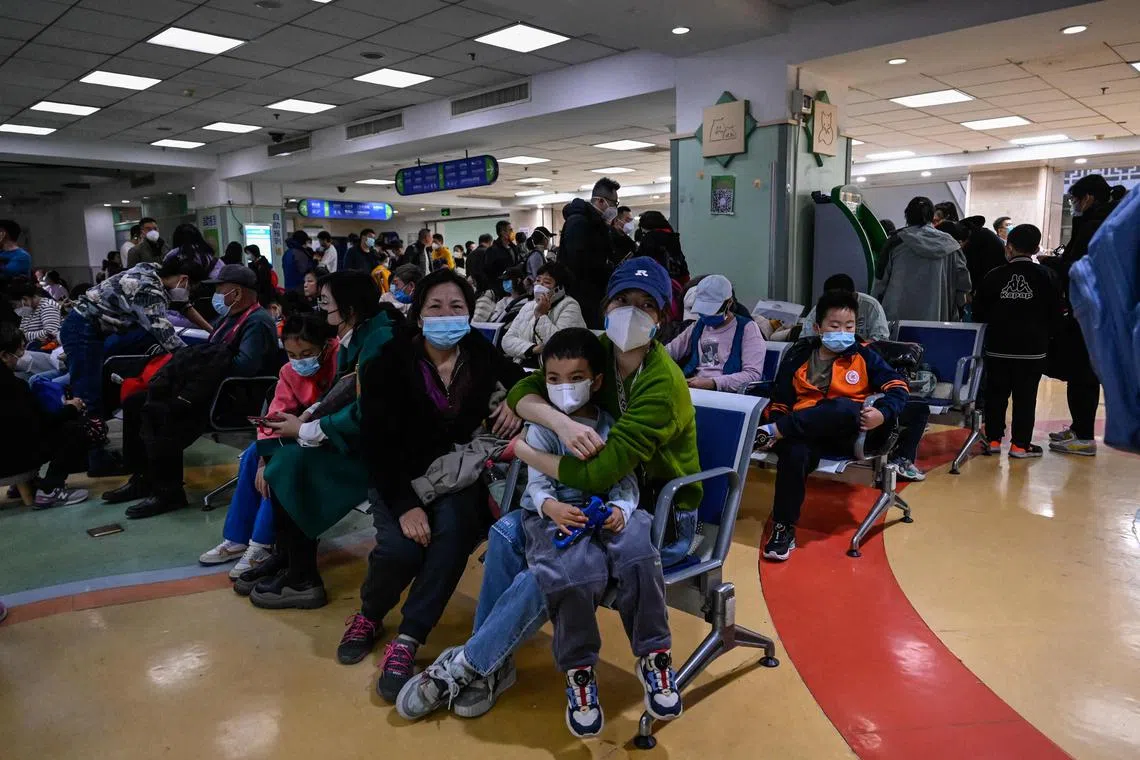China grapples with respiratory illness spike; WHO says no unusual pathogen found
Sign up now: Get insights on Asia's fast-moving developments

Groups including the Programme for Monitoring Emerging Diseases reported clusters of undiagnosed pneumonia in children in northern China.
PHOTO: AFP
Follow topic:
GENEVA - China called for vigilance on Nov 24, as a surge of respiratory illness hit its schools and hospitals.
The country is grappling with a spike in respiratory illnesses as it enters its first full winter season since it lifted strict Covid-19 restrictions in December, with cases among children appearing especially high in northern areas like Beijing and Liaoning province, where hospitals are warning of long waiting times.
The State Council said influenza would peak this winter and spring, and Mycoplasma pneumoniae infection would continue to be high in some areas in future.
It also warned of the risk of a rebound in Covid-19 infections.
“All localities should strengthen information reporting on infectious diseases to ensure information is reported in a timely and accurate manner,” the State Council said in a statement.
The situation came into the spotlight this week when the World Health Organisation (WHO) asked China for more information
Both China and the WHO have faced questions about the transparency of reporting on the earliest Covid-19 cases that emerged in the central Chinese city of Wuhan in late 2019.
On Nov 23, the WHO said China responded to its request and the data it provided suggested the cases were linked to the lifting of Covid-19 curbs, along with the circulation of known pathogens like Mycoplasma pneumoniae, a common bacterial infection that typically affects children, which has circulated since May.
The authorities began in November issuing health advisories and warning the public of long waits at crowded hospitals, but they have not imposed measures like the ones during the Covid-19 pandemic, such as mandating masks or closing schools.
There has been no indication of any undue public alarm.
Professor Bruce Thompson, head of the Melbourne School of Health Sciences at the University of Melbourne, said very preliminary data suggested there was nothing out of the ordinary.
“At this stage, there is nothing to suggest that it may be a new variant of Covid,” Dr Thompson said.
“One thing to note is that we can be reassured that the surveillance processes are working, which is a very good thing.”
Parents in Shanghai said they were not overly concerned about the wave of sickness, saying while it appeared to be more severe, they expected it to blow over soon.
“Colds happen all over the world,” said Ms Emily Wu outside a children’s hospital. “I hope that people will not be biased because of the pandemic... but look at this from a scientific perspective.”
Another mother, Ms Feng Zixun, said she was making her eight-year-old son wear a mask and wash his hands more often but nothing much more. “It’s not that bad. There are more children falling sick now but it’s mainly an issue of protection,” she said.
The WHO does not advise against travel and trade, as it has been monitoring the situation with the authorities.
The agency had also asked China for further information about trends in the circulation of known pathogens and the burden on healthcare systems. It said it was in contact with clinicians and scientists through its existing technical partnerships and networks in China.
The WHO said it decided to issue a statement on China to share available information, as it received a number of queries about it from the media.
The ProMed alert was based on a report by FTV News in Taiwan that came out on Nov 21.
Undiagnosed pneumonia was not mentioned at last week’s press conference, according to a transcript, but one speaker said everyone felt like there had been an increase in respiratory illnesses in 2023 compared with three years ago.
The speaker said global monitoring for Mycoplasma pneumoniae had been at a low over the past three years and outbreaks were cyclical, occurring every three to seven years.
‘Seasonal surge’
Many other countries have seen similar increases in respiratory diseases after easing pandemic measures.
“It is just a relatively large seasonal surge, perhaps partly due to chance and partly because there’s a bit of ‘immunity debt’ from the lesser winter surges in the last three years,” said Professor Ben Cowling, an epidemiologist at Hong Kong University.
On Nov 23, China’s National Health Commission published an interview with the state media agency Xinhua in which it advised parents what to do and mentioned that big hospitals were receiving a large number of patients and waiting times were long. It did not comment on the WHO notice.
In recent days, media in cities such as Xi’an in the north-west have posted videos of hospitals crowded with parents and children awaiting checks.
Some social media users have posted photos of children doing homework while receiving intravenous drips in hospital.
The WHO said while it was seeking additional information, it recommended that people in China follow measures to reduce the risk of respiratory illness.
Measures included vaccination, keeping distance from sick people, staying at home when ill, getting tested and medical care as needed, wearing masks as appropriate, ensuring good ventilation, and regular hand-washing, it said. REUTERS

